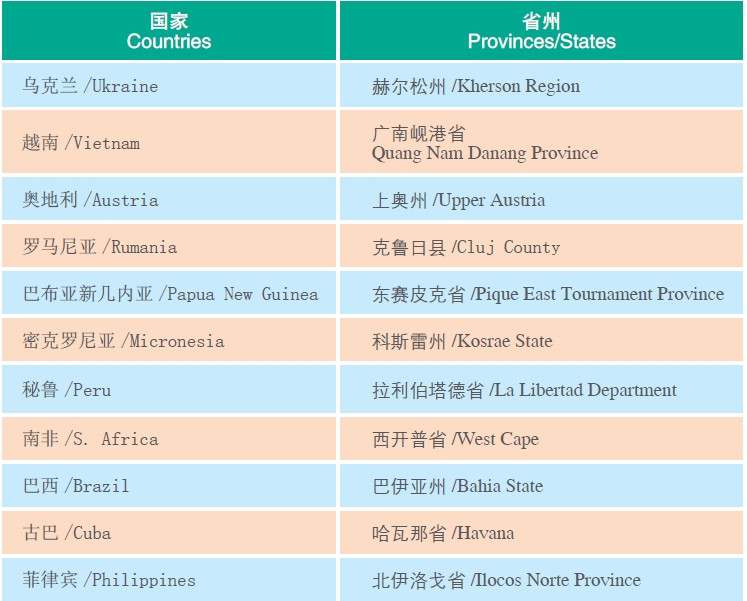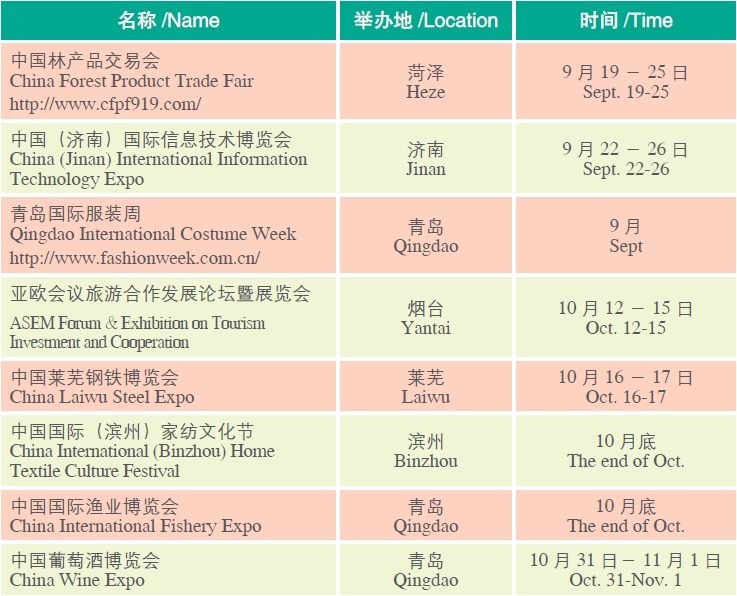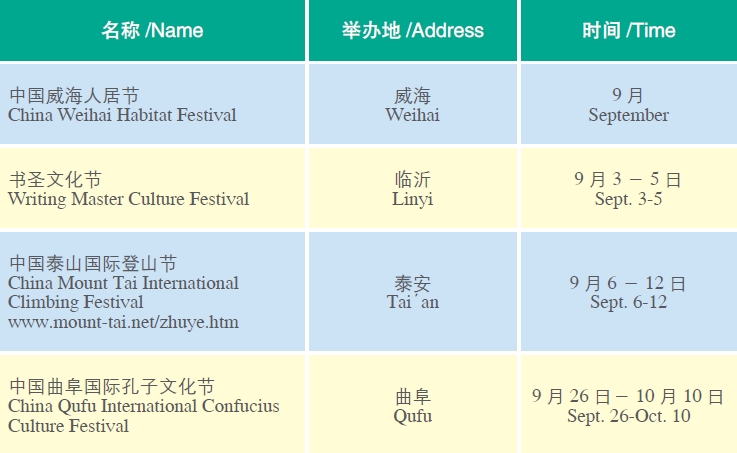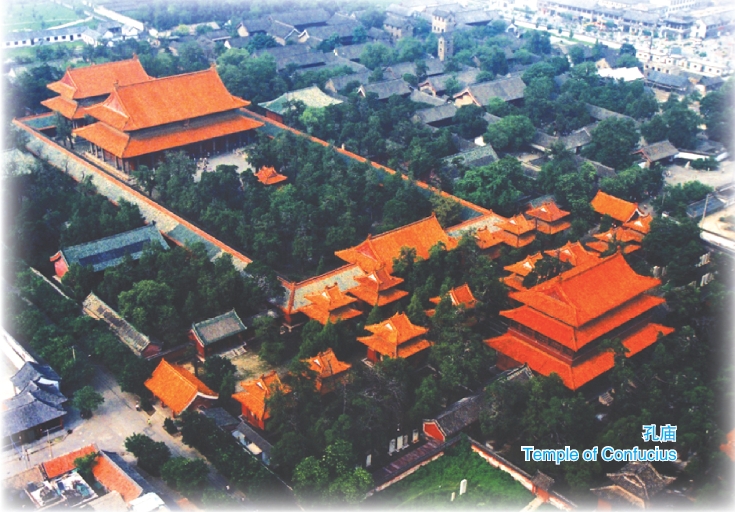Speech by the Governor
Shandong Province has important historical status in the five thousand years' civilization of China. The Confucian culture that originated in Shandong has dramatic influence both in China and overseas. Sunzi Strategic has also become significant weapon in modern commercial operation. As a coastal province with developed economy, rich resources and large population in east China, Shandong has perfect infrastructure, sufficient energy source supply and great market capacity, and it has become one of the areas endowed with most vitality and potentiality for development. The past five years is one of the best periods in economic and social development of Shandong.
In 2005, its total output value reached 1,846.83 billion Yuan, the annual economic growth rate remained being over 10% in 10 continual years, and the comprehensive economic strength came out at the top of the country. From the current year, Shandong Province will carry out the eleventh five year plan to accelerate industrialization and modernization to construct a province with strong manufacturing. Shandong will reinforce development effort in the six pillar industries of electronic information, house hold appliance, mechanical equipment, chemical industry, foods, textile costume and new materials. Here, I, on behalf of over 92 million people, cordially welcome friends and businessmen of the world to visit Shandong for more investment, cooperation and trade contacts in order to establish business opportunities and seek mutual benefit and win -win situation.
Governor of People's Government of Shandong Province
Han Yuqun
I . Survey
i. Geographic Location
Shandong Province, Lu for short, is the old site of Qi and Lu realms. It is located in east coast of China and separated from countries like Japan and ROK by sea. Its continental coastline is 3,024 km.
Shandong Peninsula extends into the sea and divides Bo Hai and Huang Hai, which endows it with advantageous location and brings more development opportunities from convenience in transportation by land and water. Total land area of the province is about 157,100 sq.km and forest coverage 24%. The province is studded with enclosed lakes like Weishan Lake and rivers like Yellow River, mother river of Chinese nation, which supplies annual water resource with gross amount of approximately 30.8 billion m3. There are also mountains like Mount Tai and Meng Shan standing in the province, providing outstanding spectacle.
People combine the prominence of Mount Tai, Yellow River and Confucius, ancestor of Confucianism, to the saying of" One Mountain, One River, One Saint" to praise the prosperousness of culture and scene of Shandong Province.
Shandong has 17 cities: Jinan, Qingdao, Zibo, Zaozhuang, Dongying, Yantai, Weifang, Jining, Tai'an, Weihai, Rizhao, Laiwu, Dezhou, Linyi, Liaocheng, Binzhou and Heze, with altogether 140 counties and county-level cities/districts under its administration. Jinan is the provincial capital city called "Spring City" for its rich springs.
Qingdao, located at the coast of Huang Hai, is the largest city of the province.
ii. Climate Features
Shandong is in the warm temperate and sub-humid monsoon climatic region, so it has clear four seasons and comfortable climate with annual mean temperature about 14 ℃ , average annual precipitation 550-950 mm, and frost-free period over 180 days in coastal area and over 220 days in inner land area.
iii. Population and Nationality
In the year 2005, total permanent population in Shandong Province is 92.4818 million. Population of Han-nationality is 91.7947 million which takes 99.26% of the total population; population of minorities such as Hui and Man is 687,100 which is 0.74% of the total population. Population density of the province is 589 persons/sq.km
iv. Infrastructure and Traffic
Airport and Aviation
Shandong now has 7 airliner and air freighter airports and more than 300 airlines including 21 departure airlines to Japan, ROK, France, Germany, America, Russia as well as Hongkong and Macao. The four airports in Jinan, Qingdao, Yantai and Weihai are international air harbors.
Harbor
Shandong has 24 harbors with annual cargo handling capacity of over 380 million tons. Ocean routes lead to over 140 countries and regions. Qingdao Port is one of the five largest harbors in Chinese mainland.
It is ranked at 3rd place with annual cargo handling capacity of over 180 million tons and container shipping as much as 6 million standard containers. In the following five years, Shandong will increase 26 sea port berths and increase cargo handling capacity of 70 million tons.
Highway
All 17 cities of the province are connected through high standard highways.
Mileage in highway open to traffic reaches over 80,000 km including expressway of 3,163 km. Mileage open to traffic and pavement quality all come out at the top level of the country. The highway transports passengers over 900 million every year.
In the following five years, Shandong will increase expressway of 555 km.
Railway
Shandong is located at the center of the south-north traffic of east China with Beijing-Shanghai railway and Beijing- Kowloon railway goes through it from north to south and Qingdao-Jinan railway goes through it from east to west. Total length of railway is over 3,400 km and it transports passengers of 40 million people every year.
Jinan Railway Station is important railway junction of the country. In the following five years, Shandong will increase electrified railway of 730 km.
Finance and Insurance
Shandong has altogether 34 banking institutions, 9 of which are foreign banks and representative office of foreign banks. 24 national insurance company set up branches in Shandong, and there are 146 specialized insurance Intermediary organs of all classes.
Communication
By the end of 2005, fixed telephone subscribers in Shandong reached 28 million with diffusion rate of 30.5%; mobile telephone subscribers reached 23.41 million with diffusion rate of 25.5%. Fixed telephone network and mobile telephone network seamlessly cover all cities, counties, towns and villages.
Internet
Now Shandong has internet users of about 8 million. All cities and counties can have access to internet through telephone, private line or broadband.
v. Foreign Affairs
Provinces, States and Cities of Friendship
Shandong has established good relationship with more than 130 foreign province s, states and cities.

Foreign-related Fairs
Based on its own industry characteristics, Shandong has staged many kinds of foreign related fairs with local features which turned out good effect in extending communication and promoting trade.

Major Festivals
Shandong is a rich land full of outstanding people, and it particularly shows the local culture and natural scene through various festivals.

vi. Higher Education and Scientific Research
Higher Education
Shandong is an important cradle of Chinese culture. Education concept of Confucius, originator of Confucian culture, cultivates the good personality of Shandong people to respect teachers and attach importance to education. Various education institutions are set up successively and education popularity degree is increased year by year which benefits all the people in the province. Now Shandong Province has 104 colleges and universities, such as Shandong University, Ocean University of China, China University of Petroleum, with students of 1.17 million; 806 medium vocational schools with students of 1.09 million; 4,404 middle schools with students of 5.92 million; 252 technician training schools with students of 320 thousand.
Scientific Research
Shandong has 330 various scientific research institutions and the research in agricultural technique and marine science, etc. is at the top level of the country. There are 32 academicians from National Academy of Science & China Engineering Academy, as well as 70,000 specialized technical personnel. In 2005, Shandong made more than 3,000 important scientific and technical achievements, 500 of which reached international leading level, and 495 of which won Provincial Science and Technology Award. Patent application amount in this year was as much as over 25,000 pieces.
vii. Tourism
General Situation
Shandong is rich in cultural relics, historical sites and famous scenic spots: world natural and cultural heritage-Mount Tai Scenic Spot, world cultural heritage- Qufu Scenic Spots of Temple, Mansion and Cemetery of Confucius, International Beer City-Qingdao and Taoism sanctum-Lao Shan, Fairyland of the World-Penglai, International Kite City-Weifang, Spring City-Jinan, etc. are particularly popular.
Shandong has perfect facilities of traveling including 460 star hotels for tourism and various tourist services. In 2005, it received domestic and oversea tourists as much as 140 million person-times and realized tourist income of 100 billion Yuan; it received tourists from abroad of 1.55 million person times and realized tourist income from abroad of 780 million dollars.
Coastal City-Qingdao
Located at the south end of Shandong Peninsula and the coast of Huang Hai, Qingdao is a unique coastal city with charming sight and comfortable climate.
Coastline of the city (including coastline of affiliated islands) is 870 km in which the continental line is 730 km which is 1/4 of continental line of Shandong. The coast detours with alternation of bay of cusp.
Qingdao is the sailing game site in 2008 Olympics. The charming and romantic beachscape, Taoism immortal hill on the sea-Lao Shan, flowery city scene-red tiles, green trees, blue sea and sky, buildings with typical European styles, modern facilities for entertainment, holiday, commerce and fairs-all these endow Qingdao, a city with combination of oriental and occidental style and harmony of hill, sea and city, with most beautiful beachscape and make it major port to receive oversea tourists. Qingdao International Beer Festival has been held successfully for 16 times. Each year it attracted millions of tourists and became the carnival of citizens and tourists. In 2005, Qingdao received tourists from abroad of 680,000 person-times, domestic tourists of 25 million person-times, and realized tourism income of 25.7 billion Yuan. Famous scenic sites in Qingdao includes: Lao Shan, Beach sightseeing, Navy Museum, Underwater World, Polar Ocean World, Badaguan Scenic Spot, etc.
Mount Tai Scenic Spot
Mount Tai was called Daizong in ancient times. The ancient emperors offered sacrifice here in worship of the heaven, so it contains rich Chinese traditional culture.
The area here is 426 sq.km and altitude of the mountain is 1,545 m. Mount Tai is great and splendorous. With long history and rich cultural relics, the mountain has been esteemed prior to the other four famous mountains in China from ancient times. In 1982, Mount Tai was listed into the first group of National Famous Scenic Sites by the State Council; in 1987, it was listed into World Natural and Cultural Concurrent Heritage by UNESCO; in 1992, it was ranked in the top 40 resorts of China.
Mount Tai now has 22 antique building groups under good protection with gross building area 140,000 m2, including 12 stone archways, 6 stone bridges, 7 stone pavilions, 1 copper pavilion and 1 iron pavilion.
Because Mount Tai has more than 2,200 stone carvings, it is praised as" China Cliff Carving Museum".

Qufu "Sankong" Scenic Spots
"Sankong" refers to Mansion, Cemetery, and Temple of Confucius. They were the living place of Confucius, founder of Confucianism, and his family. These buildings are grand and magnificent. It is the third largest ancient building group that attracts domestic and oversea Chinese to come to visit it. Mansion of Confucius occupies land 240 mu, including halls, storied building and houses, altogether 463 rooms. In 1961, it was listed into the first group of Historical and Cultural Relics under State protection; in 1994, it was listed into World Cultural Heritage together with Temple and Cemetery of Confucius. Temple of Confucius is root temple to sacrifice Confucius. Built in 478 B.C., it is the model for other more than 2,000 Confucius temples in China, Korea, Japan, Vietnam, Indonesia, Singapore, and America, the temple with longest service time in China as well as one of the most famous existing ancient building groups. It has more than 100 buildings with over 460 rooms. Area of this ancient building is about 6,000 m2. Cemetery of Confucius is the cemetery of Confucius and his descendants, including over 100,000 tombs. It is a family cemetery with longest history and largest scale in the world. In the cemetery there are thickly dotted stones.
There are more than 4,000 tombstones and inscriptions, as well as over 300 archways etc. Except the famous Han inscriptions having been transferred into Temple of Confucius, there are still inscriptions written by celebrities like Li Gefei, Wu Kuan, Huang Yangzheng, Yan Song, Kong Shangren, Gui Fu, Weng Fanggang, He Shaoji, Ruan Yuan, Shi Runzhang, Kang Youwei and lineal descendants of Confucius.

Related Articles:
Doing Business in Shandong Province of China: II. Economy
Doing Business in Shandong Province of China: III. Investment
Doing Business in Shandong Province of China: IV. Development Zones




